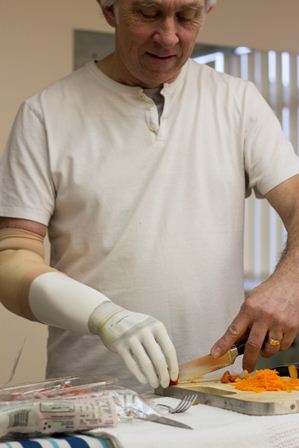First UK patient receives Ottobock bionic hand
25 January 2012
The first UK patient was fitted with Ottobock's pioneering Michelangelo Hand by Dorset Orthopaedic on 22nd January 2013. The hand has life-like, sculptural design and its fingers are made of both hard and soft materials mirroring bones, joints, muscles and tendons. It uses advanced software that increases the responsiveness and predictability of the hand, making it much easier to operate.
The robotic hand has seven different positions and uses complex gripping kinematics that use muscle signals for positioning. Actively driven components are the thumb, index finger and middle finger. The other two fingers passively follow their movements.
Dorset Orthopaedic also introduced a unique silicone ‘comfort fit’ technology. Dorset Orthopaedic’s Consultant Prosthetist & Director of Clinical Services, David Hills said, “Traditionally upper limb sockets are made from rigid materials such as glass fibre. We have however developed 100% Silicone sockets, which are proving to be much more comfortable due to their flexibility especially around bony areas such as the elbow.”
“This is a hugely exciting medical innovation, and we’re delighted that Christopher has found the Michelangelo so comfortable and easy to use,” stated Geoff Harding, Business Manager Prosthetics at Ottobock Healthcare. “We hope that Christopher’s story shows other hand amputees that real, effective solutions are available and look forward to watching his progress with Michelangelo.”

Christopher Taylor using the Michelangelo
robotic hand
The patient, Christopher Taylor from Ivybridge in Devon, lost his right hand in a jet-ski accident in August 2009. As a self-employed lifting equipment engineer, Christopher regularly climbs ladders and works atop industrial buildings and cranes. The unique four movable fingers and a thumb that can be independently positioned using muscle signals, will allow him to continue working safely.
During the trials, he quickly and easily mastered control of the prosthetic hand by using natural muscle movement and contraction in the remaining part of his arm. He said, “The more I use it the better I get at controlling it. ... The fingers move in line like a natural hand and I particularly like the way I can very quickly change the type of grip needed for a variety of everyday tasks, as easily as moving my remaining good hand.”